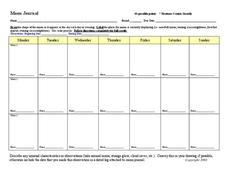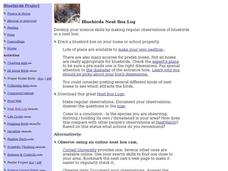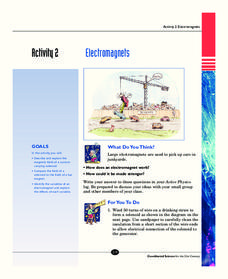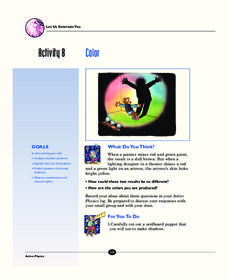Curated OER
Observing Natural Science in Action
In this observing science in action learning exercise, students look at a picture and answer a set of 6 "observation questions." Answers are included on page 2.
Curated OER
Observing Snail Behavior
In this observing snail behavior worksheet, students find a few snails, place them in an aquarium, observe for several days, then answer 5 questions about their behavior.
Curated OER
My Writing Log
In this record keeping worksheet, students will create a log to keep track of their writing. Students will generate information including observation, goal, and date.
Curated OER
Moon Journal
In this astronomy activity, students draw the shape of the moon as it appears in the sky each night for three weeks. With their drawings they include the moon phase and any unusual characteristics they observe.
Curated OER
Daily Weather Log
For this weather worksheet, students keep a log of the temperature, precipitation, air pressure, humidity and wind for a fourteen day period. They record each of these measurements twice a day.
Curated OER
Daily Weather Log
In this weather worksheet, students keep track of the temperature, precipitation, air pressure, humidity, and wind throughout the day using either provided weather instruments or ones they have created.
Curated OER
Occupational Fieldwork Survey
In this fieldwork worksheet, 8th graders record observations at a job site. Fields for notes include: occupation observed, workspace description, equipment, etc.
EngageNY
The Most Important Property of Logarithms
Won't the other properties be sad to learn that they're not the most important? The 11th installment of a 35-part module is essentially a continuation of the previous lesson, using logarithm tables to develop properties. Scholars...
It's About Time
Metals and Nonmetals
Did you know you can melt the metal gallium with just the heat of your hand? Pupils observe and test materials in order to classify them as metal or non-metal. A reading passage and analysis questions wrap up the lesson.
It's About Time
Refraction of Light
Don't shine like a diamond, refract light like a diamond. Young scientists use an acrylic block and a laser light to observe refraction. Advanced scholars figure the sine of the angles of reflection and incidence as well as mastering...
It's About Time
Chemical Names and Formulas
Abracadabra! Provide your class with the tools to perform a chemical "magic show" as they predict the charges of various ions, determine ionic compound formulas, and make observations to determine when a chemical reaction between...
Laguna Middle School
Personal Physical Fitness Plan
Sticking to a physical fitness plan can be tricky. Support young athletes' personal fitness goals with a helpful and strategie lesson plan. They reflect on their daily habits through a pre-assessment and questionnaire, create short...
Curated OER
Bluebirds Nest Box Log
In this bluebirds nest worksheet, students follow directions on how to make a blue bird nest and then answer the short answer questions about it. Students click on the links and answer the questions.
Curated OER
Dead Trees Alive! Nature Notebook
In this tree worksheet, students find a dead tree or rotting log, describe it and look for signs of living things near it and all animals they find below it.
It's About Time
Organic Substances
Host an exciting lab in which learners burn fruit rinds to better understand hydrocarbons. A reading passage and analysis questions wrap up the lesson.
It's About Time
The Electricity and Magnetism Connection
Magnets don't grow in fields, but magnetic fields are important to understand. The lesson covers the effect electricity has on magnetic fields. Scholars use a compass, magnets, and electrical wire to test magnetic fields and energy...
It's About Time
Electromagnets
Young scientists build their own electromagnet and test it by picking up paperclips. Analysis questions evaluate knowledge at the end of the activity.
It's About Time
Sounds in Strings
How many of your pupils play an instrument? A musical science lesson will help all of them understand how string instruments work. Young scientists construct a string-and-pulley system to test frequency and pitch. The lesson...
It's About Time
Identifying Matter
High schoolers test wood splints that have been soaked in mystery solutions to identify the different colors it produces when lit. The lesson concludes with a reading passage and analysis questions.
It's About Time
AC and DC Currents
An informative physics lesson includes two teacher demonstrations, one on AC currents and the other on DC currents, allowing pupils to take notes while watching. The resource includes questions to assign as homework or...
It's About Time
Circular Motion
Lead your class in this exciting activity to learn more about motion and its importance. Pupils learn about a centripetal and why it is required to maintain a constant speed in a circulating moving mass. They apply the equation for...
EngageNY
Building Logarithmic Tables
Thank goodness we have calculators to compute logarithms. Pupils use calculators to create logarithmic tables to estimate values and use these tables to discover patterns (properties). The second half of the lesson plan has scholars use...
It's About Time
Color
How can a hand puppet's shadow look like a dog? The lesson explains the science behind shadows, combining paint colors and the colors used in old televisions. Scholars use white, red, blue, and green lights to experiment with colors...
It's About Time
Concentrating on Collisions
How important is momentum? Pupils investigate and apply the definition of momentum as they conduct analyses during a series of one-dimensional collisions. They infer the relative masses of two objects by carefully staging and predicting...
Other popular searches
- Observation Log Sheet
- Science Observation Log?
- Teacher Observation Log
- Science Observation Log
- Observation Log Plants
- Moon Observation Log
- Observation Log for Infants
- Lunar Cycle Observation Log
- Sky Observation Log
- Weather Observation Log
- Lunar Cyle Observation Log
- Plant Observation Log























